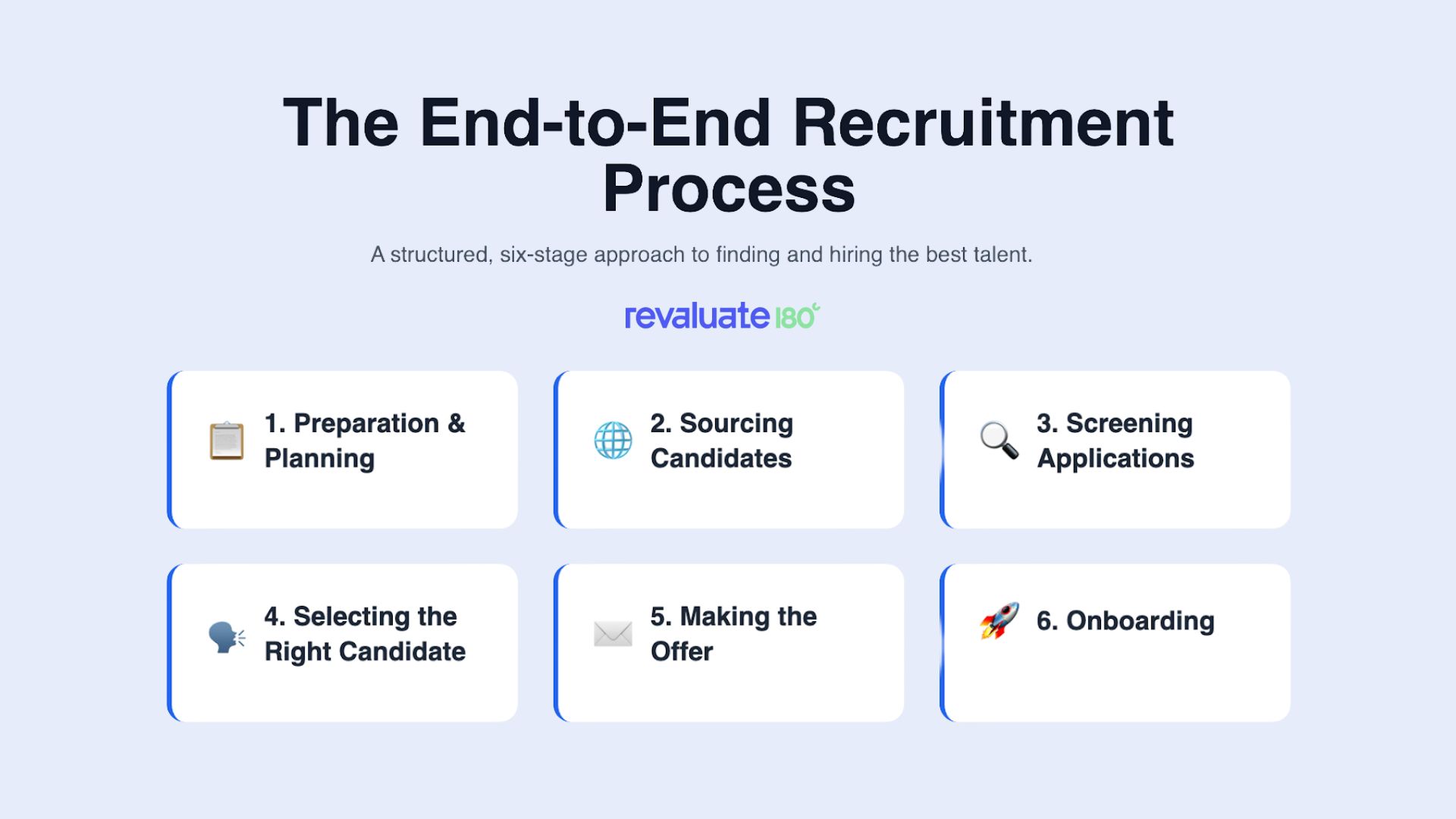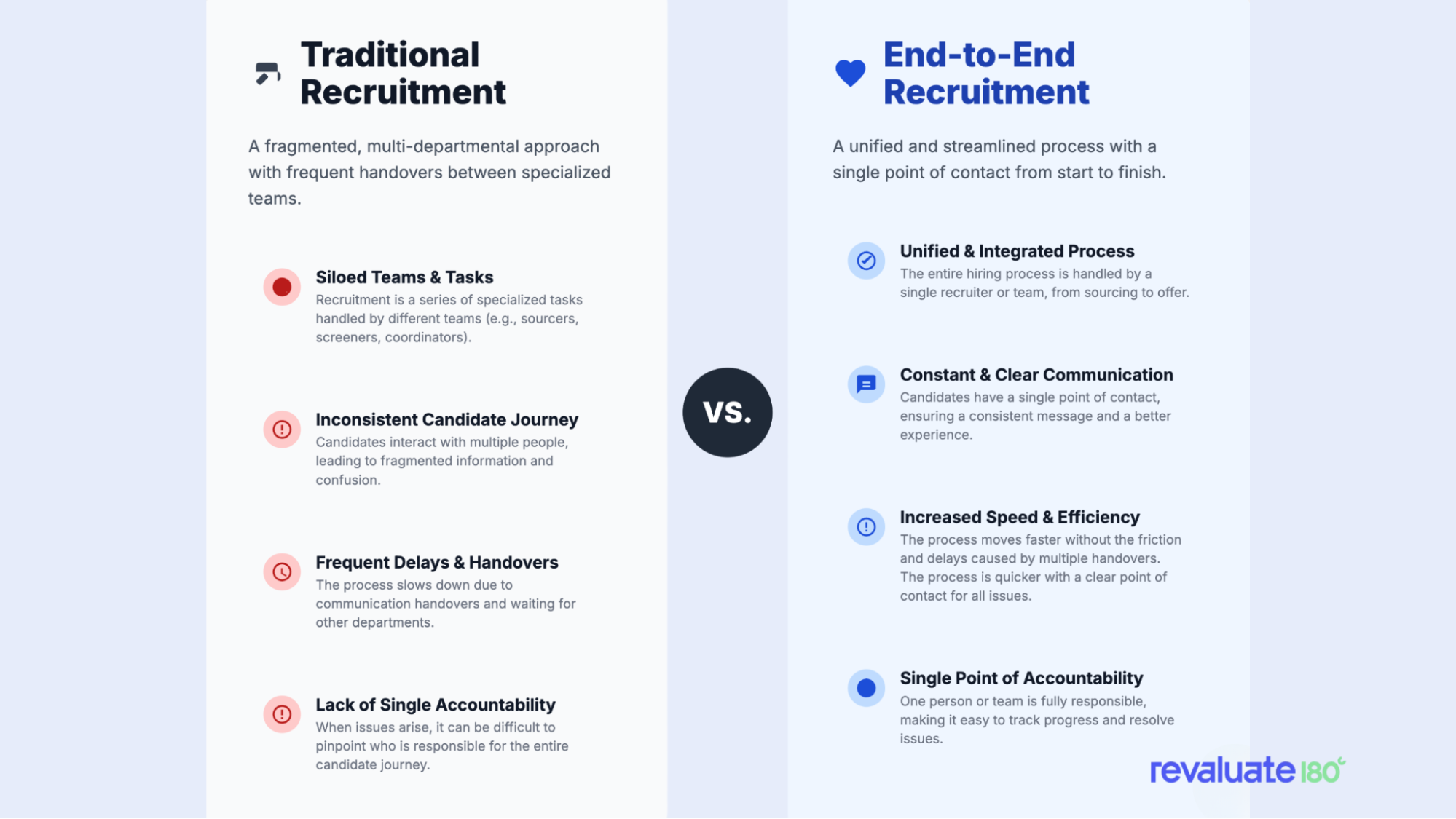In the hiring world, an end-to-end recruitment process is often referred to as full-cycle recruiting or full life-cycle recruiting. It means owning every step of the hiring process, from planning the entire job description to onboarding the candidate.
This approach can be adapted to various company sizes and industries, ranging from startups to large corporations and from technology to healthcare. Rather than splitting responsibilities across multiple teams, a single person or a unified team is assigned to guide candidates through the hiring process.
This holistic approach ensures that all your business goals are well-aligned at every phase and reduces any missing information, ultimately leading the team to make better hiring decisions. Companies that approach hiring as a continuous and integrated process in a competitive talent market will experience significant gains.
In this post, we’ll reveal the hidden potential that many companies overlook when implementing an end-to-end hiring process. By aligning these hiring and retention strategies, organizations double their retention rates and triple their productivity compared to other siloed approaches.
Key Takeaways
- End-to-end recruiting encompasses every step from planning the job to sourcing, screening, interviewing, offering, and finally onboarding the candidate under a standardized process through consistency and accountability.
- This complete cycle explored in this post fosters clear ownership and faster hiring, with each stage personalized according to the insights from the previous one. It is a co-dependent approach that can accurately predict better outcomes.
- A seamless candidate experience is crucial, as the survey finds that around 66% of applicants are more likely to accept the offer after a positive interview process, while 26% decline jobs due to poor follow-ups.
- Data and AI-driven analytics in recruitment can significantly help reduce bias and guesswork, so you can focus on skills and values to determine what long-term success means to you.
- Companies that effectively integrate recruitment and retention through analytics are most likely to achieve better outcomes, with retention rates and hiring quality twice as high and productivity thrice as high.
- Revaluate180 offers hiring solutions using AI and team dynamics data to identify candidates who fit your role and thrive in the long run within the team and the workplace culture.
What is an End-to-End Recruitment Process?
An end-to-end recruitment process means overseeing the entire hiring funnel from start to end. It begins with planning for the position and concludes with onboarding new employees and integrating them into your team.
In simple terms, the end-to-end recruiter or a small team of employees is the backbone of the entire hiring process. They handle everything from writing the job description with input from stakeholders to sourcing candidates by posting vacancies on various internal and external hiring platforms, screening and interviewing potential candidates, extending offers, and finally ensuring a smooth transition into the company. In summary, the end-to-end recruiter (whether a team or an individual) is not just accountable but integral to the organization's success.
Suppose a team of recruiters is responsible for hiring candidates. In that case, tasks are divided so one person sources candidates, another person screens them, and a hiring manager makes the final decision. This traditional recruitment model eliminates miscommunication between silos. For example, instead of posting ads and forwarding resumes, the recruiter continually refines candidate profiles based on early interviews and feedback. This is only possible when the company understands its value and tracks candidate interviews with the help of effective data analytics and internal intellectual properties.
Now that we know what an end-to-end recruitment process is, let’s explore the essential stages of it:
Stages of the End-to-End Recruitment Process
The stages of an end-to-end recruiting process can be broken down into distinct steps that depend on one another. Here are the key stages:

1. Preparation and Planning
The first step is to define the role and the strategy for conducting the process. This involves collaborating with hiring managers and leadership to ensure that the required skills, along with relevant experience and essential qualities, are well-documented for the best hire.
Recruiters draft a clear job description that includes technical requirements, soft skills, workplace values, and growth potential. They must also establish a realistic timeline and decide upon a key hiring metric, which includes time-to-hire and candidate satisfaction, among others.
Planning also involves determining the recruitment budget and identifying channels such as job boards, referrals, social media, and recruiting events. Practical data analysis can guide all these decisions.
2. Sourcing Candidates
Next up is active and passive sourcing. End-to-end recruiters cast a vast network to post job sites, leverage professional sources like LinkedIn, and other industry groups, and tap into existing talent pools, including employee referrals and other internal databases.
Because recruiters are responsible for the entire process, they must remain continuously engaged to tweak outreach messages or branch into new channels as needed. This proactive and involved approach is crucial in today's competitive talent market. Employer branding is highly beneficial for hiring, as it allows you to showcase your company culture and mission in job ads, which can attract better-fitted applicants through social media.
3. Screening Applications
Once candidates respond to the job post, the recruiter begins screening to filter the best matches, which often starts with reviewing the resumes and applications. However, many industry experts now consider plain resume filtering to be outdated, mainly due to the prevalence of low-effort AI-generated resumes. Consequently, recruiters are shifting towards skills-based assessments.
Instead of solely matching the keywords in the resume, tools and tests are available to assess the actual abilities and personality fit. For example, today’s recruiters use short online assessments or preliminary video interviews to gauge communication skills. These assessments can include coding challenges for technical roles, case studies for managerial positions, or situational judgment tests for customer-facing roles.
4. Selecting the Right Candidate
After shortlisting candidates from various sources, the end-to-end recruiters work with hiring managers to conduct interviews and evaluate the finalists. This often involves multiple interview rounds, including technical, behavioral, and sometimes assessment interviews.
Crucially, recruiters prefer to coordinate with everyone’s availability to ensure each interview has clear goals and often sit in as interviewers. This continuous involvement allows the recruiter to address any immediate concerns promptly, enabling them to rectify them immediately.
If a technical skill is identified as a gap in earlier hires, it will be probed more thoroughly for assurance. After interviews, the hiring team deliberates to ensure the decisions are facilitated and compares candidates against the initial criteria, while highlighting the critical data points.

Exclusive Access to AI-Powered Hiring Analytics
For a limited time, get exclusive access to AI-powered hiring analytics and create aligned, collaborative, and high-performing teams.
 Smarter Hiring Decisions
Smarter Hiring Decisions
 Reduce Expensive Turnover
Reduce Expensive Turnover
 AI-Driven Insights
AI-Driven Insights
 Optimize Team Performance
Optimize Team Performance

5. Making the Offer
Once the top candidate is chosen, the recruiter can extend the offer. This stage involves drafting a competitive compensation package based on market data and negotiating terms to officially offer the position to the candidate.
Recruiters who believe in growth tend to make quick decisions when hiring. The transition from interview to job offer must be seamless; otherwise, recruiters risk losing candidates to competitors. Therefore, clear communication is crucial, as it enables you to effectively explain the benefits of the position, including signing bonuses and growth opportunities, which can help candidates feel valued.
6. Onboarding
End-to-end recruiting does not stop at hiring. It also includes onboarding the new employee, which is equally vital in the process. A successful onboarding process promises to accelerate how quickly new hires become productive and engaged, helping them meet the company's expectations.
Recruiters often stay involved even after hiring to ensure a warm welcome for new employees, thereby contributing further to the company culture. Onboarding may include coordinating orientation sessions, introducing the hire to the team, arranging training schedules, and setting initial goals upon joining. This is the effective onboarding where it pays off.
End-to-End Recruitment vs. Traditional Recruitment

The traditional recruitment model is believed to incorporate split hiring into silos. For instance, one team might handle sourcing while another handles the interview process and offers. In this traditional model, handover happens at a very early stage. This is where the potential candidate is passed to a recruiter and then a hiring manager. While this method has been used for a while, it breaks down communication, resulting in unnecessary delays and inconsistencies.
On the other hand, end-to-end recruiters are accountable for the entire hiring process. They treat it as a single point of contact where candidates and stakeholders collaborate. This practice is especially beneficial because responsibilities don’t fall through the cracks, and recruiters can stay in touch with the candidates throughout the process.
This unified approach addresses several differences. Here’s how:
- Single accountability: There’s one person or team assigned to hire the candidate. If something goes wrong, the full-cycle recruiter or the team is responsible for resolving the issue.
- Speed: Without wasting time on different departments, steps can be proceeded immediately after defining the role and the interview schedule.
- Constant communication: Candidates always deal with the same recruiter or the team authority, which further helps avoid any confusion. This mode of communication helps candidates stay connected through one channel.
- Improved experience: Since recruiters understand the candidate’s entire journey, they can help personalize the process by answering questions and gauging the right fit in a way that traditional recruiters cannot.
Benefits of End-to-End Recruiting

Embracing a full-cycle recruitment approach can bring all the strategic benefits. Here’s how:
- Accountability: With one person or team responsible for the whole process, every candidate stays on the radar without losing prospects between stages or pointing fingers at anyone.
- Quick Hire Time: While traditional methods can waste a lot of time in handoffs, an end-to-end strategy works precisely because it saves time and energy. No more delays, and faster hiring is at its best.
- Consistent Candidate Experience: Candidates appreciate a smooth, personal hiring journey that is known for an elevated manner. This consistency boosts acceptance rates and ensures every talent feels heard and valued.
- Better Team Alignment: Because full-cycle recruiters involve the team early in the process, recruiters can easily pick up detailed feedback at any stage. This versatility gives a new edge to hiring and emphasizes skills over looks.
- Strong Candidate Relationship: Since full-circle recruiters are there to assess at each stage, they can build meaningful relationships with candidates through more interactions.
- Culture Fit and Clarity: Early planning and continued narrative with potential candidates can bring out the best in talent. Recruiters can precisely assess a candidate's fit with the company's values and growth potential. This clarity prevents any unwanted surprises and helps make clear decisions right away.
How Data Improves the End-to-End Recruitment Process
Data analytics is foundational to the best hiring practices. Data-driven hiring takes the end-to-end recruitment process to the next level, as it helps guide better decisions. Let’s see how:
Avoid Gut Feelings
Relying on your intuition alone can lead to inaccurate decisions. Statistics and case studies have repeatedly shown that data-driven organizations experience an increase in employee retention of over 30% compared to traditional methods.
Instead of favoritism, recruiters use structured data analytics to confidently shortlist candidates tailor-made for the role. They utilize key metrics, including skills tests, interview scores, and reference checks, to accurately predict hiring success.
Bias Reduction
Human bias can creep in unnoticed. Practical hiring tools can flag unconscious preferences to ensure diverse and merit-based choices. For instance, one advantage of AI screening is the consistent feeding of data. Since it evaluates everyone against the same standardized criteria, it can offer a bias-free perspective towards the data.
Every qualified candidate is meticulously assessed and not overlooked because of surface differences or unconscious bias.
Resume Filtering is Outdated
Modern recruiting experts have warned that candidate resumes no longer suffice. Even mediocre candidates can look polished and comprehensive with AI augmenting cover letters and CVs.
Companies that thrive on growth now emphasize skill assessments and practical work samples over just resumes any day. As one industry panel has noted, our goal is to move away from resume-based filtering techniques and towards proper skill-based hiring.
Measures Culture and Team Fit
Practical data tools can help you stay connected to your company culture and team dynamics. This can include psychometric assessments (a study to determine a candidate’s psychological traits) or team fit surveys.
Since cultural misalignment is the most frequently cited reason for early turnover, measuring value alignment of candidates becomes crucial to ensure who will stay after the initial six months.
Tracking Performance and Turnover
Using data analytics techniques doesn’t stop at hiring. If you want to know your candidate’s top performance and turnover, recruiters can refine their future searches by tracking these key metrics.
If data suggests that applicants from a specific background tend to stay longer or contribute more, recruiters can suggest sourcing more from those channels. Arguably, if hires from one source are reported to leave, they can rethink that channel to make feasible decisions.
How Revaluate180 Helps with Data-Driven Hiring
At Revaluate180, we’re dedicated to offering our expertise with powerful analytics to ensure your potential candidates are the best match for your company and help you select the best ones to retain longer.
Our platform offers solutions beyond just resumes, where our core values are built into analyzing candidates’ values, motives, and team fit to identify those most likely to thrive in the long term in terms of success and career. Whether it’s refining job profiles, curating candidates, supporting the onboarding process, or designing a complete management plan for effective hiring, we’re ready to build a high-performing team for your organization’s success.
Final Thoughts
In today’s competitive landscape, you need more than references and resumes. End-to-end recruiting, aided by insightful analytics, can help you make informed decisions that are no longer influenced by unconscious biases. This integrated approach will enable you to align your candidate's potential with company goals. With data on your side, let the end-to-end hiring process become your new standard, and see it reflected in your company’s performance.

Exclusive Access to AI-Powered Hiring Analytics
For a limited time, get exclusive access to AI-powered hiring analytics and create aligned, collaborative, and high-performing teams.
 Smarter Hiring Decisions
Smarter Hiring Decisions
 Reduce Expensive Turnover
Reduce Expensive Turnover
 AI-Driven Insights
AI-Driven Insights
 Optimize Team Performance
Optimize Team Performance

FAQs
What is the meaning of end-to-end recruitment?
End-to-end recruitment, or full-cycle recruitment, is a comprehensive hiring approach where a single person or team is responsible for planning and executing the entire hiring process.
What is full-cycle recruiting?
A full-cycle recruitment is just another name for the end-to-end recruitment process.
What’s the difference between end-to-end and traditional recruiting?
While end-to-end hiring offers full ownership and consistency across all stages, traditional hiring suggests splitting the tasks across multiple roles.
Is the complete life cycle recruiting better for small businesses?
Yes! Full-cycle recruiting is often more efficient and cost-effective for small businesses that require a better candidate experience with fewer handoffs. It is best for building a strong foundation for your company culture.
What are the end-to-end recruitment roles and responsibilities?
They usually include job planning, sourcing, screening, interviewing, offering the job, and onboarding the new candidate to the team.
